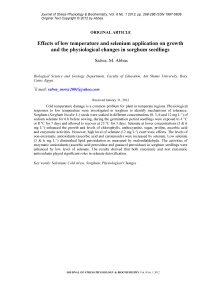Effects of low temperature and selenium application on growth and the physiological changes in sorghum seedlings
Автор: Abbas salwA. M.
Журнал: Журнал стресс-физиологии и биохимии @jspb
Статья в выпуске: 1 т.8, 2012 года.
Бесплатный доступ
Cold temperature damage is a common problem for plant in temperate regions. Physiological responses to low temperature were investigated in sorghum to identify mechanisms of tolerance. Sorghum (Sorghum bicolorL.)seeds were soaked in different concentrations (0, 3, 6 and 12 mg L-1) of sodium selenate for 6 h before sowing, during the germination period seedlings were exposed to 4 °C or 8 °C for 7 days and allowed to recover at 25 °C for 3 days. Selenate at lower concentrations (3 & 6L-1) enhanced the growth and levels of chlorophylls, anthocyanine, sugar, proline, ascorbic acid and enzymatic activities. However, high level of selenate (12 mg L-1) exert toxic effects. The levels of non-enzymatic antioxidants (ascorbic acid and carotenoids) were increased by selenate. Low selenate (3 & 6L-1) diminished lipid peroxidation as measured by malondialdehyde. The activities of enzymatic antioxidants (ascorbic acid peroxidase and guaiacol peroxidase) in sorghum seedlings were enhanced by low level of selenate. The results showed that both enzymatic and non enzymatic antioxidants played significant roles in selenate detoxification.
Selenium, cold stress, sorghum, physiological changes
Короткий адрес: https://sciup.org/14323594
IDR: 14323594
Текст научной статьи Effects of low temperature and selenium application on growth and the physiological changes in sorghum seedlings
The temperatures on the Earth’s surface are very different, changing during the seasons as well as during the day and night. Low temperatures act as an a biotic stress factor that has a strong impact on the survival, growth, reproduction and distribution of plants. For plants, the chilling temperatures usually range from 0 to 15°C. Low temperature affects germination, seedling growth, and overall crop growth and productivity (Yan et al. 2010; Zhang et al. 2010). On the cellular level, chilling can affect membranes and their lipid composition thereby changing the water status of the cells/ plant.
In addition, chilling may impair water absorption by the roots and water transport to the shoot (Aroca et al. 2001). Antioxidant capacity increases during cold acclimation in several plants as an adaptive mechanism to low temperature (Foyer and Noctor 2005).
Selenium (Se) is a trace element that can function as an essential nutrient for humans and animals or as an environmental toxicant, the boundary between the two is narrow and depends on its chemical form concentration, and other environmentally regulating variables (Shardendu et al. 2003). Stimulating effects to the additions of small amount of Se on plant growth and yield have been observed by several researchers (Terry 2000). Plants take up sealant (SeO4 2-) the most abundant bioavailable form of Se in soils via sulfate transporters in roots (Shibagaki et al. 2002). Numerous studies have shown that at low concentrations, Se exerts a beneficial effect on growth and stress tolerance of plants by enhancing their antioxidative capacity and thereby improve growth and yield (Kong et al. 2005). Oxidative stress generate reactive oxygen species (ROS). Excess ROS can damage cellular lipids, proteins or DNA thus inhibiting signal transduction pathways (Pennanen et al. 2002). Exogenous selenium (low concentration) can reduce the intensity of peroxide processes of membrane lipids and affect the activity of redox enzymes and thereby change the oxidation-reduction status of the cell, increasing stress tolerance (Vikhreva et al. 2002). Moreover, positive influence of selenium on changes in the activity and permeability of the cellular membrane, this may be one of the symptoms of the influence of selenium on plants (Filek et al. 2008). Selenium can modify uptake and accumulation of minerals which are important for metabolism. Selenium metabolism is closely connected with the metabolism of nitrogenous substances in plants particularly with amino acids. The application of selenite triggered a higher foliar concentration of H2O2 and a higher induction of lipid peroxidation, observed after the selenate application indicate that the selenate form of Se is less toxic than selenite (Rios et al. 2009). Also, the plants treated with selenate induced higher increases in enzymes that detoxify H2O2, especially ascorbate peroxidase (APX), as well as an increase in the foliar concentration of antioxidant compounds such as ascorbate (AsA)
and glutathione (GSH). Chu et al (2010) reported that protective role of Selenium on wheat plant, under cold stress,significantly reduced MDA content and the rate of O 2 • production in wheat seedlings grown under cold stress. Additionally, Selenium treatments significantly increased contents of anthocyanins, of seedlings subjected to cold stress ,which have the ability to scavenge free radical s . Also the effects of Selenium on peroxidases activity in seedlings exposed to cold stress were also reported by (Chu et al. 2010).
The aim of the study indicated to showed that an application of sodium selenate at low rates could provide an ecological adaptation for young seedlings subjected to stress conditions.
MATERIALS AND METHODS
Plant growth Parameters:
In this work, seeds of wheat (Triticum aestivum L.) were surface sterilized with 1.0% sodium hypochloride. The seeds, were presoaked in distilled water (control) or in aqueous solutions of selenium (0, 3, 6 and 12 mg Se L– 1 in the form of sodium selenate) for 6 h at room temparature. After pre-treatment, the solutions were decanted off and the seeds were washed with distilled water and dried. Fifteen seeds from every application were arranged in 15 cm Petri dishes covered with two sheets of filter paper moistened with 10 mL of distilled water. Following sowing, germination experiments were carried by placing Petri dishes in an incubator at 22±1°C for 3 days. Three-day-old-seedlings were exposed to low temperature stress by placing them in a cold room at a temperature of 4°C and 8°C, for 10 days. After exposure to cold stress, the seedlings were placed back to the climatic chamber at 22°C, where they have recovered for 48 hrs. At the end of experiment (15 days), the lengths of the radicle and shoot in mm, and fresh weights of the seedlings (g/seedling) from 20 seeds were recorded. The dry weights of seedlings were measured by drying the seedlings at 75°C, to give a constant weight.
Photosynthetic pigments:
Chlorophyll a, b, and carotenoids in the second leaf of the wheat seedlings were extracted in 80% water acetone. The pigments were determined spectrophotometrically after centrifugation of extract at 3000 rpm for 5 min and estimated by the method of Metzner et al. (1965).
Anthocyanin:
Anthocyanin content was estimated according to the method of Krizek et al. (1993). Leaf samples were homogenized in 10 mL of acidified methanol (HCl: methanol, 1:99, v/v). The homogenate was centrifuged at 18 000 g for 30 min at 4°C, and then the supernatant was filtered through Whatman No1 to remove particulate matter and was stored in darkness at 5°C for 24 h. The amount of anthocyanin was determined from the absorbance at 550 nm. Anthocyanin content was expressed as µmol/g FW and the concentration of anthocyanin was calculated using the extinction coefficient of anthocyanin ε = 33 000 mol-1 cm-1 .
Total soluble sugars (TSS):
Total soluble carbohydrates (TSS) were extracted by overnight submersion of dry tissue in 10 ml of 80% (v/v) ethanol at 25°C with periodic shaking, and centrifuged at 600g. The supernatant was evaporated till completely dried then dissolved in a known volume of distilled water to be ready for determination of soluble carbohydrates (Homme et al. 1992). TSS were analyzed by reacting of 0.1 ml of ethanolic extract with 3.0 ml freshly prepared anthrone (150 mg anthrone + 100 ml 72% H2SO4) in boiling water bath for ten minutes and reading the cooled samples at 625 nm using Spekol SpectrocololourimeterVEB Carl Zeiss (Yemm and Willis, 1994).
Determination of the membrane status:
The plasma membrane intactness was estimated through the leakage of electrolytes, described by Sun et al. (2006). Fresh leaves (0.300 g) were placed in tubes, containing 30 ml bidistilled water and kept for 2 h in water bath at 30 °C for measuring the initial conductivity (EC1). The final electrolyte conductivity (EC2) was measured after boiling the plant samples for 15 min. The leakage percentage was calculated as (EC1/EC2) x 100 %.
Determination of the malondialdehyde (MDA) content:
Lipid peroxidation was measured using the 2-thiobarbituric acid (TBA) reaction (Heath and Packer 1968). The plant homogenate (extracted with 0.1 % trichloroacetic acid) was mixed with potassuim phosphate buffer (pH 7.0) and the TBA-reagent (0.5 % thiobarbituric acid in 20 % trichloroacetic acid, w/v) in a ratio 1:1:2 (v/v) and the reaction was developed for 30 min in boiling water bath. The levels of TBA-conjugated substances was calculated using the extinction coefficient of 155 mM cm-1 from the data read at 532 nm after applying the correction read at 600 nm (for non-specific absorption).
Determination of ascorbic acid:
Ascorbic acid was determined as described by Mukherjee and Choudhuri (1983). 4 ml of the extract was mixed with 2 ml of 2 % dinitrophenylhydrazine (in acidic medium) followed by the addition of 1 drop of 10 % thiourea (in 70 % ethanol). The mixture was boiled for 15 min in a water bath and after cooling to room temperature, 5 ml of 80 % (v/v) H 2 SO 4 was added to the mixture at
0°C (in an ice bath). The absorbance was recorded at 525 nm using spectrophotometer.
Measurement of proline content:
Determination of the free proline levels was done according to Bates et al. (1973). Proline was extracted in 3 % (w/v) aqueous sulfosalicylic acid. The reaction mixture contained supernatant, acetic acid and ninhydrin reagent in a ratio 1:1:1 (v/v) and was boiled for 1h in water bath. Proline quantity was estimated from the data received after reading the toluol fraction at 520 nm.
Enzyme activities:
Peroxidase: For the analyses of guaiacol peroxidase 0.200 g plant tissue was homogenized in 100 mM potassium phosphate buffer (pH 7.0), containing 1 mM ethylenediaminetetraacetic acid
(EDTA) and 0.5 % insoluble polyvynil pyrrilidone (the tissue/ buffer ratio of 1:5, w/v). After centrifugation (20 min at 12 000 x g) the guaiacol peroxidase activity was estimated by the method of Polle et al. (1994).
Ascorbic acid peroxidase , plant tissue was homogenized in 50 mM potassium phosphate buffer (pH 7.0), containing 5 mM EDTA, 2 mM sodium ascorbate, 0.5 % insoluble polyvynil pyrrilidone (Nakano and Asada 1981), and centrifuged at 16 000 x g for 5 min. The reaction medium contained 50 mM potassium phosphate buffer (pH 7.0), 0.1 mM EDTA, 0.5 mM sodium ascorbate and 6 mM hydrogen peroxide. The oxidation of sodium ascorbate in the presence of APX started by adding of 9.7 M hydrogen peroxide and was followed at 290 nm for 30 sec.
Table 1: Changes in certain growth criteria of sorghum (Sorghum bicolor L.) seedlings grown under cold stress conditions after 13 days of germination as influenced by seed soaking in various concentrations of selenium prior to germination.
|
Cold stress |
Concentrations of selenium (mg L- 1 ) |
Plumule length (cm) |
Radicle length (cm) |
Fresh wt. of seedlings (g) |
Dry wt. of seedlings (g) |
|
(Control) |
4.50 ± 0.05 |
5.76 ± 0.06 |
0.08 ±0.04 |
0.013 ± 0.08 |
|
|
4 °C |
0 |
3.92 ** ± 0.06 |
4.41 ** ±0.04 |
0.06 ** ±0.01 |
0.012 ** ±0.07 |
|
3 |
5.53 ** ± 0.04 |
6.87 ** ±0.06 |
0.10 ** ±0.05 |
0.016 ** ±0.02 |
|
|
6 |
5.32 ** ± 0.03 |
6.21 ** ±0.07 |
0.09 ** ±0.04 |
0.015 ** ±0.03 |
|
|
12 |
3.21 ** ± 0.05 |
4.05 ** ±0.09 |
0.06 ** ±0.06 |
0.012 ** ±0.07 |
|
|
L.S.D. at: |
0.05 |
0.14 |
0.17 |
0.00 |
0.00 |
|
0.01 |
0.20 |
0.25 |
0.00 |
0.00 |
|
|
8 °C |
0 |
4.32 ± 0.04 |
5.00 ** ±0.02 |
0.07 ** ±0.02 |
0.013 ±0.04 |
|
3 |
7.58 ** ± 0.09 |
8.41 ** ±0.08 |
0.11 ** ±0.05 |
0.018 ** ±0.02 |
|
|
6 |
6.24 ** ± 0.08 |
7.52 ** ±0.07 |
0.10 ** ±0.04 |
0.017 ** ±0.09 |
|
|
12 |
3.76 ** ± 0.07 |
4.32 ** ±0.03 |
0.06 ** ±0.08 |
0.013 ±0.05 |
|
|
L.S.D. at: |
0.05 |
0.23 |
0.25 |
0.00 |
0.00 |
|
0.01 |
0.33 |
0.35 |
0.00 |
0.00 |
|
Values ± SD are mean from 20 independent experiments. **, Highly significant change.
Table 2: Changes in photosynthetic pigments of the plumules of sorghum ( Sorghum bicolor L.) seedlings grown under cold stress conditions after 10 days of germination as influenced by seed soaking in various concentrations of selenium prior to germination.
|
Cold stress |
Concentrations of selenium (mg L- 1 ) |
Chlorophyll (a) |
Chlorophyll (b) |
Chlorophylls (a+b) |
Carotenoids |
Total pigments |
|
(Control) |
0.33±0.06 |
0.58 ±1.05 |
0.91 ±0.03 |
0.74 ±0.05 |
1.65 ±0.06 |
|
|
4 °C |
0 |
0.29 * ±0.03 |
0.55 * ±0.08 |
0.84 * ± 0.05 |
0.59 ** ±0.04 |
1.43 ** ±0.03 |
|
3 |
0.49 ** ±0.01 |
0.50 ** ±0.07 |
0.99 * ±0.04 |
0.53 ** ±0.03 |
1.52 ** ±0.01 |
|
|
6 |
0.31 ±0.02 |
0.51 ** ±0.09 |
0.82 ** ±0.07 |
0.59 ** ±0.09 |
1.41 ** ±0.06 |
|
|
12 |
0.19 ** ±0.04 |
0.53 ** ±0.05 |
0.72 ** ±0.06 |
0.58 ** ±0.08 |
1.30 ** ±0.04 |
|
|
L.S.D. at: |
0.05 |
0.03 |
0.02 |
0.05 |
0.02 |
0.07 |
|
0.01 |
0.05 |
0.03 |
0.08 |
0.03 |
0.10 |
|
|
8 °C |
0 |
0.30 ±0.05 |
0.41 ** ±1.12 |
0.71 ±0.09 |
0.75 ±0.07 |
1.46 ±0.02 |
|
3 |
0.21 * ±0.07 |
0.37 ** ±1.03 |
0.58 ** ±0.04 |
0.28 ** ±0.05 |
0.86 ** ±0.07 |
|
|
6 |
0.31 ±0.03 |
0.52 ±0.08 |
0.83 ± 0.06 |
0.60 ** ±0.03 |
1.43 * ±0.04 |
|
|
12 |
0.30 ±0.09 |
0.53 ±0.07 |
0.83 ±0.07 |
0.57 ** ±0.06 |
1.39 * ±0.06 |
|
|
L.S.D. at: |
0.05 |
0.12 |
0.10 |
0.22 |
0.08 |
0.21 |
|
0.01 |
0.17 |
0.15 |
0.32 |
0.12 |
0.31 |
|
Values ± SD are mean from 3 independent experiments.*, Significant change.
** , Highly significant change.
--^-Temp. 4°C
Temp 8°C
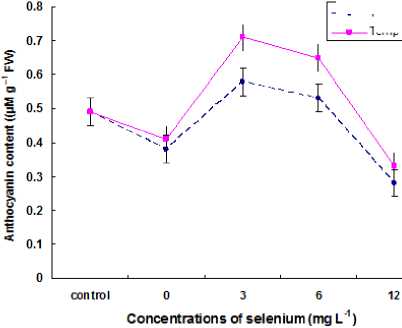
Fig. 1: Anthocyaninscontent of sorghum seedlings grown under cold stress conditionsas influenced by seed soaking in selenium concentrationspriorto germination. Error bars indicate ± SE.
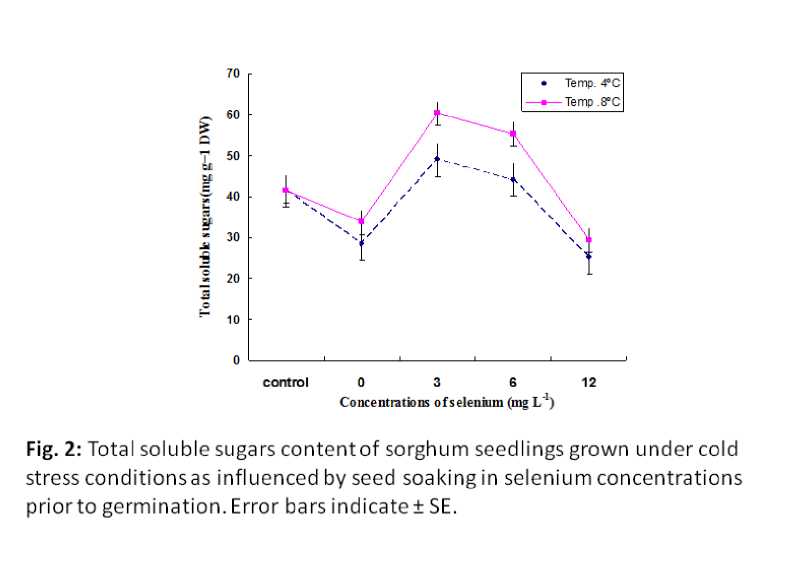
Fig. 2: Total soluble sugars content of sorghum seedlings grown under cold stress conditionsas influenced by seed soaking in selenium concentrations priorto germination. Error bars indicatet SE.
0 --------- control
0 3 6
Concentrations of selenium (mg L'1)
• Temp. 4°C
—■—Temp 8°C
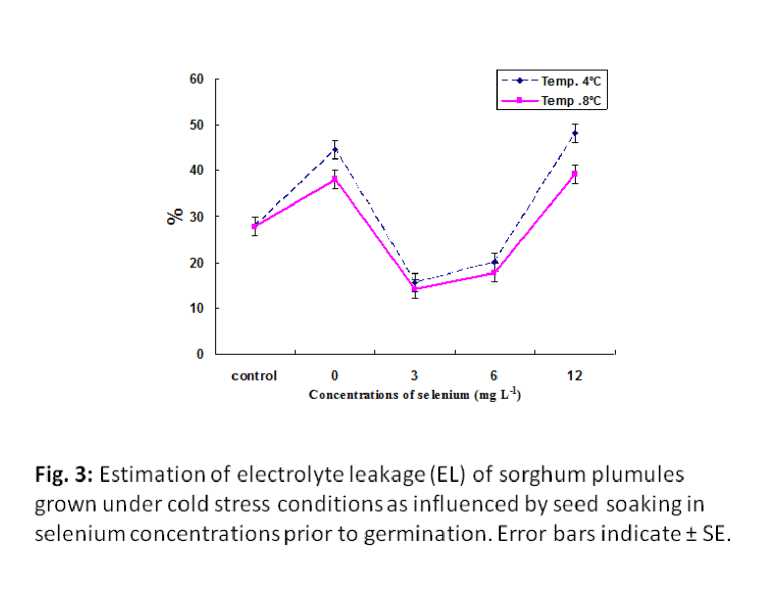
Fig. 3: Estimation of electrolyte leakage (EL) of sorghum plumules grown under cold stress conditionsas influenced by seed soaking in seleniumconcentrationspriorto germination. Error bars indicatet SE.
control
Concentrations of selenium (mg L ,
- -♦--Temp. 4°C
■ Temp .8°C
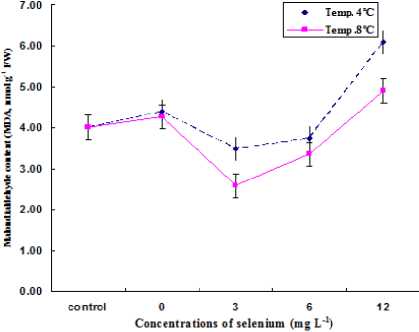
Fig. 4: Malondialdehyde (MDA) content of sorghum seedlings grown under cold stress conditionsas influenced by seed soaking in selenium concentrationspriorto germination. Error bars indicatetSE.
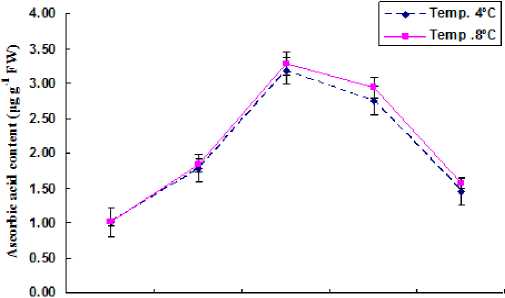
control 0 3 6 12
Concentrations of selenium (mgL"1)
Fig. 5: Ascorbic acid content of sorghum seedlings grown under cold stress conditions as influenced by seed soaking in selenium concentrations priorto germination. Error bars in dicate ±SE.
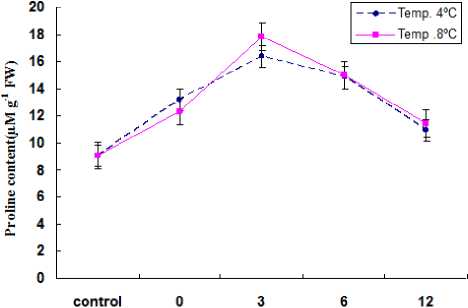
Concentrations of selenium (mg L"1)
Fig. 6: Proline content of sorghum seedlings grown under cold stress conditionsas influenced by seed soaking in selenium concentrationsprior to germination. Error bars indicate! SE.
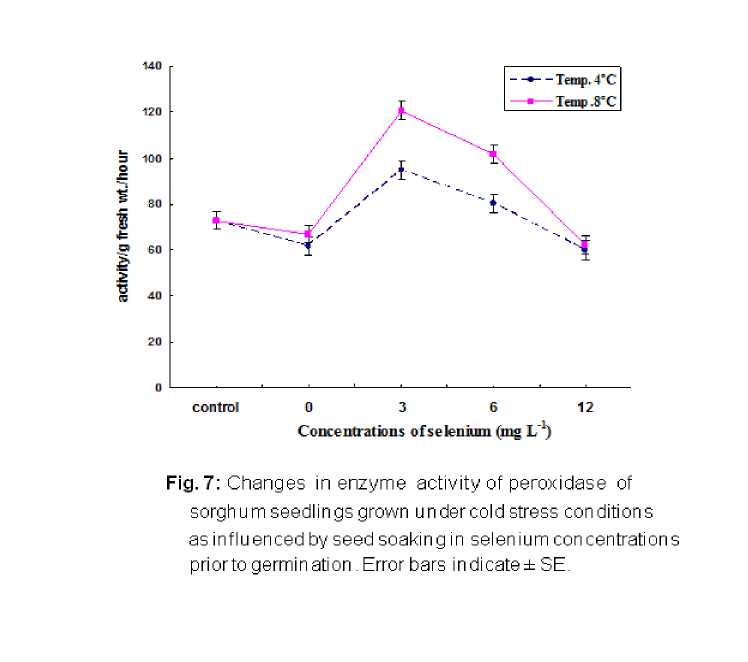
Fig. 7: Changes in enzyme activity of peroxidase of sorghum seedlings grown under cold stress conditions as influenced by seed soaking in selenium concentrations priorto germination. Error bars indicate± SE.
control
0 3 6
Concentrations of selenium (nig L"1)
- -•—Temp, 4®C
■ Temp,8=C
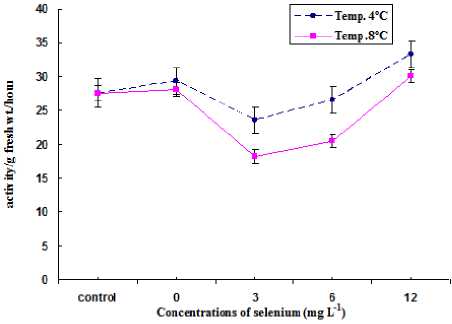
Fig. 8: Changes in enzyme activity of ascorbic acid peroxidase of sorghum seedlings grown under cold stress conditionsas influenced by seed soaking in selenium concentrations prior to germination. Error bars indicate ± SE.
RESULTS AND DISCUSSION
Growth parameters:
Many crops often encounter cold stress in growing periods, which brings greater loss to agricultural production. It has already been established that selenium increases resistance and antioxidant capacity of plants, under cold stress. The obtained results indicate that all growth parameters (plumule length, radicals length, fresh and dry weights of wheat seedlings) growing under cold stress (at 4 0C and 8 0C) were increased in response to low concentrations of selenium (3, 6 mg L- 1) as compared to controls and untreated with selenium . On the other hand , application of high selenium concentration (12 mg L-1), significantly reduced these parameters Table (1). It is obvious that plants treated with selenium induced higher increases in growth parameters of sorghum seedlings under cold stress ,thus results indicated that Se addition increased plant biomass production.
The chilling effect is manifested by physiological perturbations, generally called low-temperature injury (Yan et al. 2010). The chilling stress below 15°C often happens in the rice causing heavy seed loss and a delayed growth period (Sharifi 2010). Low temperature affects germination, seedling growth, and overall maize crop growth and productivity (Leipner et al. 1999). Exposure of plants to chilling enhanced the production of reactive oxygen species (ROS) in plant cells which is responsible for peroxidation of membrane lipids (Egert and Tevini 2002). Recent researches have demonstrated that Selenium not only able to promote growth and development of plants but also increase resistance and antioxidant capacity of plants subjected to various stresses included low temperature stress, it can scavenge reactive oxygen species (Djanaguiraman et al. 2005). Selenium affected plant growth promotion might be the result of increased starch accumulation in chloroplasts
(Xue et al. 2001). Selenium at low concentration, it could act as an antioxidant enhancing growth seedlings, whereas at higher concentration it could act as a growth-inhibiting agent (Turakainen 2007). Selenium supply improved the recovery of potato plants from light and chilling stress (Chu et al. 2010). Plants treated with Selenium and subjected to low temperature generally grew better than plants grown without the addition of Selenium (Lyons et al. 2009).
Effect of selenium on photosynthetic pigments.
Low temperature is one of the most important factors that limit photosynthetic activity. It has been reported that chlorophyll a and b content was decreased in plants when plants were subjected to cold treatment (Wu et al. 2006).
Aghaee et al. (2011) showed that higher contents of chlorophyll in leaves of rice seedlings,under stress were associated with tolerance to chilling. However, chilling temperature could disrupt key processes in photosynthesis, including thylakoid electron transport, carbon assimilation and stomatal control (Allen and Ort 2001). In addition, cold stress can affect photosynthesis rates by inhibiting the light and dark reactions of photosynthesis and change in the activities of several enzymes of photosynthetic carbon assimilation.
The increase in chlorophyll a and chlorophyll b contents of wheat seedlings may be attributed to selenium effect on protection of chloroplast enzymes and thus increasing the biosynthesis of photosynthetic pigments (Pennanen et al. , 2002). High concentration of selenium induced reduction in photosynthetic pigments content observed in this study is consistent with the result of Padmaja et al. (1995). The selenite ion increased the contents of carotenoids and chlorophyll a , change in the photosynthetic pigments level is likely to have been connected with different effects of the selenium ions on the oxidation-reduction status of leaves.
Anthocyanins:
Plants accumulate a large number of metabolites namely flavonoid, and anthocyanins compounds, as osmoprotectants, in response to environmental stress. All these compounds have been reported to exhibit a wide range of protective functions in plants under stress. Anthocyanin can protect chlorophylls from photooxidation, compared with the other components they are the best indicators of an oxidative plant stress caused by the external factors ,its accumulate under cold temperatures. Also anthocyanins are reported to Several reports proposed that are mainly involved in photoprotection at low temperatures (Hatier and
Gould 2008). Additionally, compared with the control, Selenium treatments significantly increased contents of anthocyanins, and flavonoids of seedlings subjected to cold stress which have the ability to scavenge free radicals and inhibit membrane lipid peroxidation of seedlings (Chu et al. 2010).
Antioxidant compounds content (anthocyanins, flavonoids, and phenolic compounds) increased by different selenium treatments in wheat seedlings under cold stress (Liang et al. 2009). The results demonstrated that Selenium supply could increase antioxidant capacity of seedlings, and optimal Selenium supply reduced production of free radicals.
Soluble Sugar Contents:
Seedlings adapt to stress environment by different mechanisms, including changes in morphological and developmental pattern as well as physiological and biochemical processes. Adaptation is associated with maintaining osmotic homeostasis by metabolic adjustments that lead to the accumulation of metabolically compatible compounds such as soluble sugar. Cold acclimation is associated with multiple mechanisms that include changes accumulation of substantial amounts of compatible solutes, such as soluble sugars (Chinnusamy et al. 2007). Accumulation of soluble sugars was reported in many plant species under diverse abiotic stress conditions which might indicate that osmolyte could increase the tolerance of plants to stress conditions (Xiong and Zhu 2002). Soluble sugars increased sharply right after transferring the cultures of strawberry to the low temperature (Xiao et al. 2009). Long-term acclimation to the cold in herbaceous plants is strongly correlated with the recovery of photosynthesis at low temperature and the maintenance of soluble carbohydrate reserves (Strand et al. 2003).
Sucrose, glucose, fructose and oligosaccharides are commonly found in soluble sugars are serve as osmoprotectants and play a role in protecting cellular membranes from damage caused by dehydration and they may act function as nutrients which make plants survive as well as recover from freezing-stress (Xiao et al. 2009). It has been hypothesized that photosynthetic activity is regulated in a feedback manner by soluble sugars. Exposure to low temperatures increased the leakage of solutes in mung bean seedlings, such as soluble sugars and free amino acids (Chang et al. 2001). Pennanen et al. (2002) have showed that plant growth promoted by selenium is due to the increased starch accumulation in chloroplasts. At an optimal level Selenium appears to promote tuber growth; potato tubers and rapidly expanding leaves in lettuce and ryegrass leaves are strong sinks for carbohydrates (Xue et al. 2001).
Electrolyte leakage:
The results in this study (Fig 3) showed that electrolyte leakage in selenium - treated of wheat plants leaves under cold stress highly significantly decreased at concentrations of 3 and 6 mg L- 1 as compared with control and untreated seedlings.
While high concentration of selenium (12 mg L- 1) resulted in increase in electrolyte leakage.
Electrolyte leakage has been thought to be an important index of the physiological functions of the cell. Drought, salinity, and high and low temperatures initially damage the structure of the cell membrane, thereby affecting its function, leading to an increase in membrane permeability, and resulting in leakage of intracellular contents. Electrolyte leakage indicator as chilling injuries increased in Stylosanthes guianesis under chilling conditions due to damage of the membrane system (Zhou et al. 2005). Autocatalytic peroxidation of membrane lipids can be triggered by AOS, resulting in loss of membrane semipermeability, one of the primary mechanisms of stress injury. Electrolyte leakage and lipid peroxidation level in mung bean plant increased under chilling conditions . Zhou et al. (2002) reported the membrane system of Stylosanthes guianensis was damaged under chilling stress due to the induction of oxidative damage is related to the imbalance of ROS production. In cereals the plasma membrane is the most susceptible membrane structure to freezing damages, and the impaired integrity is connected with leakage of electrolytes and other solutes (Pearce 2001).
Freezing stress, which causes extracellular icecrystal formation, freeze-induced dehydration, and concentration of cell sap, has major mechanical impacts on cell walls and plasma membranes and leads to cell rupture (Margesin et al. 2007). It has been shown that plant membrane damage during chilling is related to the peroxidation of membrane lipid due to the stress-induced accumulation of free radicals (Chen and Li 2002).
Low concentrations of selenium decrease electrolyte leakage as compared to control. Therefore, this indicated that the reduced electrolyte leakage may be a direct consequence of selenium treatment The electrolyte leakage and the MDA content were significantly lower in the embryonic axes of seeds soaked in selenite than in seeds soaked in water (Stanisława et al. 2011). Seppanen et al. (2003) showed that selenium- treated Lettuce plants was more tolerant and the integrity of membranes was improved during oxidative stress (low temperature).
Lipid peroxidation:
MDA was taken as a marker for the degree of lipid peroxidation as MDA produced by peroxidation of unsaturated fatty acids in plant cell membrane. (Fig 4) Malondialdehyde (MAD) increased in wheat seedlings under cold stress as compared to control. The high concentration of selenium (12 mg L-1) showed high significant increase in this content. On the other hand, high significant decreases in lipid peroxidation content were observed by using the lower concentrations of selenium as compared to control.
Chilling-enhanced lipid peroxidation, as indexed by malondialdehyde (MDA) content, in maize cells and wheat seedlings (Chen and Li 2002). MDA is a common product of lipid peroxidation. In the present study, MDA content is an expression of lipid peroxidation was increased by low temperature treatment. The accumulation of MDA is often used as an indicator of lipid peroxidation and a sensitive diagnostic index of oxidative injury (Wu et al. 2006). lipid peroxidation level in mung bean plant increased under chilling conditions, due to the induction of oxidative damage is related to the imbalance of ROS production (Zhou et al. 2002). Adaptation is associated with maintaining osmotic homeostasis by metabolic adjustments that lead to the accumulation of metabolically compatible compounds such as soluble sugar, malondialdehyde
(MDA) and proline. The adaptation of plant cells to low temperature is based on their ability to maintain saturation of fatty acids in membrane lipids, thus modifying membrane fluidity (Szalontai et al. 2003). Low level of selenium significantly diminished lipid peroxidation which measured as malondialdehyde (product of lipid peroxidation). The high level of selenium exerted an increase in lipid peroxidation (MAD) as compared with low selenium but less than that of the control plants. The decrease in lipid peroxidation by selenium may be attributed to its effect on the activity of antioxidant enzymes and/or the increased levels of water soluble ascorbic acid and glutathione (Pennanen et al. 2002).
Ascorbic Acid:
The obtained results revealed that the content of ascorbic acid was increased in selenium-treated wheat seedlings under cold stress as compared with control (Fig. 5). Meanwhile, the high concentration of selenium (12 mg L- 1) lead to highly significantly reduction in ascorbic acid content. Results of the present investigation showed that the amounts of ascorbic acid increased in selenium-treated sorghum seedlings under cold stress, this increment was greater at 8 °C than at 4 °C.
Ascorbic acid carries out a number of nonantioxidant functions in the cell. It has been implicated in the regulation of the cell division, cell cycle progression (Olga et al. 2003). Ascorbate has been shown to act as antioxidant in the non-enzymatic detoxification of ROS (Smirnoff et al. 2001; Ruth et al. 2004). Ascorbate plays an important role in the removal of H 2 O 2 and GSH together with it is oxidized form (GSSG), which maintains a redox balance in the cellular compartments (Ruth 2002; Huang and Guo 2005). The antioxidant defense system of plants includes the low molecular weight (water soluble)
antioxidants, which scavenge reactive oxygen radicals under short-term low temperature and they are substrates for the antioxidative enzymes (Wu et al. 2004). Exogenous selenium can affect the activity of redox enzymes and thereby change the oxidation reduction status of the leaves increasing its stress tolerance (Vikhreva et al. 2002).
Proline Content:
Many reports indicated that proline accumulated during many biotic and abiotic stress . The higher level of free proline in cold-stressed plants has been suggested as a factor conferring chilling tolerance (Hawrylak-Nowak et al. 2010). It is clear from the presented results that chilling effectively enhanced the proline accumulation under chilling stress conditions. Positive correlations between the accumulation of endogenous proline and improved cold tolerance have been found in maize (Zhou et al. 2002). The present results are supported by that of Chen and Li (2002), who reported most of the accumulated proline in maize cells, during a prolonged chilling treatment.
The effect of selenium on the proline level could be due to its effect on one of proline metabolism enzymes . Accumulation of proline was reported in many plant species under diverse abiotic stress conditions ,which might indicate that osmolyte could increase the tolerance of plants to stress conditions (Xiong and Zhu 2002). Proline is considered as a signal/regulatory compound able to activate multiple physiological or molecular mechanisms. The role of endogenous proline under oxidative stress includes stabilization of protein complexes, regulation of cytosolic pH, regulation of NAD/NADH ratio or as a scavenger of oxygen free radicals (Ghars et al. 2008).
Antioxidants:
Antioxidative enzymes like peroxidase (POD) and Ascorbic acid peroxidase (APX), are the most important components in the scavenging system of ROS. Plants respond to oxidative stress through increasing the enzymatic and non-enzymatic antioxidants (Cao et al. 2004; Egert and Tevini 2002).
The studies suggested that plant had signal molecules sensing the environmental stress, protective them against the damage caused by stress environment (Ya et al. 2011). There are some reports detailing changes in the activities of enzymes involved in antioxidant metabolism in response to low temperature stress (Wu et al. 2004). Plant itself could induced its defensive system to protect against free radical when suffered abiotic or biotic stresses, as shown by the transient increases of superoxide dismutase (SOD), and ascorbate peroxidase (APX) activities (Hong et al. 2011). peroxidase (POD) activities increased and then decreased gradually with the duration of cold treatment time in rice seedlings (Foyer and Noctor 2011).
Ascorbate peroxidase (APX) is one of the most important enzymes of the AsA-GSH cycle and plays a vital role in plant defense against oxidative stress by catalyzing the conversion of H 2 O 2 to H 2 O. The results indicate that higher APX activity enhances H 2 O 2 -scavenging capacity and protects wheat from lipid peroxidation, under cold stress (Sato et al. 2011).
The protective role of selenium on the cold stress in wheat seedlings could be due to, reduction of oxygen radicals, osmotic regulation by synthesis of osmoregulatory compound, and increasing the biosynthesis of enzymatic and non-enzymatic antioxidants. Recent researches have demonstrated that Selenium able to promote growth and development of plants and increase antioxidant capacity of plants subjected to stresses (Peng et al. 2002). The protective effect of selenium on plants has been demonstrated as a decrease in lipid peroxidation and an increase in the activity of antioxidant enzymes thereby improving stress resistance (Hartikainen et al. 2000; Sandalio et al. 2001).
Список литературы Effects of low temperature and selenium application on growth and the physiological changes in sorghum seedlings
- Aghaee, F., Moradi, H., Zare-Maivan, F., Zarinkamar, H., Pour Irandoost and Sharifi P. (2011). Physiological responses of two rice (Oryza sativa L.) genotypes to chilling stress at seedling stage. Afr. J. of Biotech., 39, 7617-7621
- Allen, D.J. and Ort, D.R. (2001). Impacts of chilling temperatures on photosynthesis in warm-climate plants. Trends Plant Sci., 6, 36-42.
- Aroca, A. F., Tognoni, J.J, Irigoyen, M., Sanchez-D?az, and Pardossi, A. (2001). Different root low temperature response of two maize genotypes differing in chilling sensitivity. Plant Physiol. Bioch., 39, 1067-1073.
- Bates, L.S., Waldern, R.P. and Teare, I.K. (1973). Rapid determination of free proline for water stress studies. Plant Soil 39, 205 -208.
- Cao, X., Ma, QL and Tu, C. (2004). Antioxidative responses to arsenic in the arsenic-hyperaccumulator Chinese barke fern (Pteris vittata L.). Environ. Poll., 128, 317-25.
- Chang, M., Chen, S., Lee and Chen, Y. (2001). Cold-acclimation and root temperature protection from chilling injury in chilling-sensitive mung bean (Vigna radiata L.) seedlings. Botany Bull. Acad. Sci., 42, 53-60.
- Chen, W.P. and Li P.H. (2002). Membrane stabilization by abscisic acid under cold aids proline in alleviating chilling injury in maize (Zea mays L.) cultured cells. Plant Cell Environ., 25, 955-962.
- Chinnusamy, V., Zhu, J.H. and Zhu, J.K. (2007). Cold stress regulation of gene expression in plants. Trends Plant Sci., 12, 444-451.
- Chu, X., Yao, Z. and Zhang (2010). Responses of wheat seedlings to exogenous selenium supply under cold stress. BioI. Trace Elem. Res., 136, 355-363.
- Djanaguiraman, M., Devi, A.K., Shanker, A., Sheeba and Bangarusamy, U. (2005). Selenium-an antioxidative protectant in soybean during senescence. Plant Soil 272, 77 -86.
- Egert, M. and Tevini, M. (2002). Influence of drought on some physiological parameters symptomatic for oxidative stress in leaves of chives (Allium schoenoprasum). Environ. Exp. Bot., 48, 43-49.
- Filek, M., Keskinen, R., Hartikainen, H., Szarejko, A., Janiak, Z. and Miszalski, Golda, A. (2008). The protective role of selenium in rape seedlings subjected to cadmium stress. J. of Plant Physiol., 165, 833-844.
- Foyer, C.H. and Noctor, G. (2005). Redox homeostasis and antioxidant signaling: A metabolic Interface between stress perception and physiological responses. Plant Cell 17, 1866-1875.
- Foyer, C.H. and Noctor, G. (2011). Ascorbate and glutathione: the heart of the redox stat. Plant Physiol., 155, 2-18.
- Ghars, M.A., Parre, E., Debez, A., Bordenave, M., Richard, L., Leport, L., Bouchereau, A., Savoure, A. and Abdelly, C. (2008). Comparative salt tolerance analysis between Arabidopsis thaliana and Thellungiella halophila, with special emphasis on K+/Na+ selectivity and proline accumulation. J. of Plant Physiol., 165, 588-599.
- Hartikainen, H., Xue, T. and Piironen, V. (2000). Selenium as an anti-oxidant and pro-oxidant in ryegrass. Plant and Soil 225, 193-200.
- Hatier, J.H.B. and Gould, K.S. (2008). Foliar anthocyanins as modulators of stress signals. J. of Theoretical Biol., 253, 625-627.
- Hawrylak, Nowak, B., Matraszek, R.and Szymanska, M. (2010). Selenium modifies the effect of short-term chilling stress on cucumber plants. BioI. Trace Elem. Res., 10.1007/s12011-010-8613-5.
- Heath, R.L. and Packer, L. (1968). Photoperoxidation in isolated chloroplasts, Archief Biochem. Biophys., 125, 189-198.
- Homme, P.M., Gonzalez, B. and Billard, J. (1992). Carbohydrate content, frutane and sucrose enzyme activities in roots, stubble and leaves of rye grass (Lolium perenne L.) as affected by sources/link modification after cutting. J. of Plant Physiol., 140, 282-291.
- Hong, Cao, C.h., Sun, H., Shao and Xin-Tao Lei (2011). Effects of low temperature and drought on the physiological and growth changes in oil palm seedlings. Afr. J. of Biotech., 14, 2630-2637.
- Huang, M. and Guo, Z. (2005). Responses of antioxidative system to chilling stress in two rice cultivars differing in sensitivity. Biol. Plantarum, 49, 81-84.
- Kong, L. and Wang, Bi. D. (2005). Selenium modulates the activities of antioxidant enzymes, osmotic homeostasis and promotes the growth of sorrel seedlings under salt stress. Plant Growth Reg., 45, 155-163.
- Krizek, D.T., Kramer, G.F., Upadhyaya, A. and Mirecki, R. (1993). UV-B Response of cucumber seedling grown under metal halid and high pressure sodium/deluxe lamps. Physiol. of Plant, 88, 350-358.
- Leipner, J., Fracheboud, P. and Stamp, (1999). Effect of growing season on the photosynthetic apparatus and leaf antioxidative defenses in two maize genotypes of different chilling tolerance, Environ. Exp. Bot., 42, 129-139.
- Liang, L.H., Mei, X., Lin, F., Xia, J., Liu, S.J. and Wang, J.H. (2009). Effect of low temperature stress on tissue structure and physiological index of cashew young leaves. Ecol. Environ. Sci., 18, 317-320.
- Lyons, G.H., Genc, Y., Soole, K., Stangoulis, J.C., Liu, F. and Graham, R.D. (2009). Selenium increases seed production in Brassica. Plant and Soil, 318, 73-80.
- Margesin, R., Neuner, G. and Storey, K.B. (2007). Cold-loving microbes, plants, and animals -fundamental and applied aspects. Naturwissenschaften 94, 77-99.
- Metzner, H., Rau, H. and Senger, H. (1965). Untersuchungen zur Synchronnisierbarkeit einzelner Pigmentmangel Mutanten von Cholrella Planta 65, 196.
- Mukherjee, S.P.and Choudhuri, M. A. (1983). implications of water stress-induced changes in the levels of endogenous ascorbic acid and hydrogen peroxide in Vigna seedlings. Plant Physiol., 58, 166 -170.
- Nakano, Y.and Asada, K. (1981). Hydrogen peroxide is scavenged by ascorbatespecific peroxidase in spinach chloroplasts. Plant Cell Physiol., 22, 867-880.
- Olga, B., Eija, V. and Kurt, F. (2003). Antioxidants, oxidative damage and oxygen deprivation stress: a review. Ann. of Bot., 91, 179-194.
- Padmaja, K., Somasekharaiah, B.V.and Prasad, A.R. (1995). Inhibition of chlorophyll synthesis by selenium: involvement of lipoxygenase mediated lipid peroxidation and antioxidant enzymes. Photosyn., 31, 1-7.
- Pearce, R.S. (2001). Plant freezing and damage. Ann. Bot., 87, 417-424.
- Peng, X.L., Liu, Y.Y. and Luo, S. (2002). Effects of selenium on lipid peroxidation and oxidizing ability of rice roots under ferrous stress. J. Northeast Agric. Univ., 19, 9-15.
- Pennanen, A., Xue, T. and Hartikainen, H. (2002). Protective role of selenium in plant subjected to severe UV irradiation stress. J. App. Bot., 76, 66-76.
- Polle, A., Otter, T. and Siefert, F. (1994). Apoplastic peroxidases and lignification in needles of Norway spruce (Picea abies L.). Plant Physiol., 106, 53-60.
- Rios, J.J., Blasco, B., Cervilla, L.M., Rosales, M.A., Sanchez-Rodriguez, E., Romero, L. and Ruiz, J.M. (2009). Production and detoxification of H2O2 in lettuce plants exposed to selenium. Ann.of App. Biol. 154, 107-116.
- Ruth, G. (2002). Oxidative stress and acclimation mechanisms in plants. The Arabidopisis Book 1~20.
- Ruth, G. A., Neval, E. and Lenwood, S.H. (2004). Role of superoxide dismutases (SODs) in controlling oxidative stress in plants. J. of Exp. Bot., 372, 1331-1341.
- Sandalio, L.M., Dalurzo, M., Gomez, M.C., Romero-Puertas and del Rio L.A. (2001). Cadmium-induced changes in the growth and oxidative metabolism of pea plants. J. of Exp. Bot., 52, 2115-26.
- Sato, Y., Masuta Y., Saito K., Murayama, S. and Ozawa, K. (2011). Enhanced chilling tolerance at the booting stage in rice by transgenic over expression of the ascorbate peroxidase gene, OsAPXa. Plant Cell Rep.,30, 399-406.
- Shardendu, S. N., Boulyga, S.F. and Stengel, E. (2003). Phytoremediation of selenium by two halophyte species in subsurface flow constructed wetland. Chemosphere 50, 967-973.
- Sharifi, P. (2010). Evaluation on Sixty-eight Rice Germplasms in Cold Tolerance at Germination Stage. Rice Sci., 1, 77-81.
- Shibagaki, N., Rose, A.,McDermott, J.P., Fujiwara, T., Hayashi, H., Yoneyama, T. and Davies, J.P. (2002). Selenate-resistant mutants of Arabidopsis thaliana identify Sultr1;2, a sulfate transporter required for efficient transport of sulfate into roots. Plant J. 29, 475-486.
- Smirnoff, N., Conklin, L. and Loewus, F.A. (2001). Biosynthesis of ascorbic acid is plants: a renaissance. Ann Rev Plant Physiol. Plant Mol. Biol., 52, 437-67.
- Stanislawa, P., Ewelina, R. and Ewa, K. (2011). The protective role of selenium in recalcitrant Acer saccharium L. seeds subjected to desiccation. J. of plant physiol., 168, 220-225.
- Seppanen, M. Turakainen, M. Hartikainen H.(2003). Selenium effects on oxidative stress in potato. Plant Science., 165, 311-319.
- Strand, A., Foyer, C.H., Gustafsson, P., Gardestrom, P. and Hurry, V. (2003). Altering flux through the sucrose biosynthesis pathway in transgenic Arabidopsis thaliana modifies photosynthetic acclimation at low temperatures and the development of freezing tolerance. Plant Cell Environ., 26, 523-535.
- Sun, X., Hu, Q. and Tan, L. (2006). Effects of molybdenum on antioxidative defense system and membrane lipid peroxidation in winter wheat under low temperature stress. Journal Plant Physiol. Mol. Biol., 2, 175-182.
- Szalontai, B., Kota, Z., Nonaka, H. and Murata, N. (2003). Structural consequences of genetically engineered saturation of the fatty acids of phosphatidylglycerol in tobacco thylakoid membranes. An FTIR study. Biochem., 42, 4292-4299.
- Terry, N., Zayed, M.P., de Souza and Tarun, A.S.(2000). Selenium in higher plants. Annual Rev. Physiol. Plant Mol. Biol., 51, 401-432.
- Turakainen, M. (2007). Selenium and its Effects on Grovvth, Yield and Tuber Quality in Potato. University of Helsinki Helsinki pp, 50-55.
- Vikhreva, V.A., Balakhnina, T.I. and Gins, V.K.(2002). Effect of selenium on intensity of peroxide processes and enzyme activity in Caucasian goat's rue leaves under extreme growing condition. Russ. Agric. Sci., 2, 1-4.
- Wu, J.H., Yang, L. and Sun, G.R. (2004). Generation of activated oxygen and change of cell defense enzyme activity in leaves of maize seeding under the stress of low temperature. Bull. of Bota. Res., 4, 456-459.
- Wu, X., Zhu, L. and Zhu, W.M. (2006). Physiological effects of exogenous nitric oxide in tomato seedlings under NaCl stress. Sci. Agric. Sinica 3, 575-581.
- Xiao, B.Z., Chen, X., Xiang, C.B., Tang, N., Zhang, Q.F. and Xiong, L.Z.(2009). Evaluation of seven function-known candidate genes for heir effects on improving drought resistance of transgenic rice under field conditions. Molecular Plant 2, 73-83.
- Xiong, L. and Zhu, J. K. (2002). Molecular and genetic aspects of plant responses to osmotic stress. Plant Cell and Environ., 25, 131-139.
- Xue, T., Hartikainen, H. and Piironen, V. (2001). Antioxidative and growth-promoting effect of selenium in senescing lettuce. Plant Soil 27, 55-61.
- Ya, L., Haoru, T.and Yong, Z. (2011). Production of Reactive Oxygen Species and Antioxidant Metabolism about Strawberry Leaves to Low Temperatures. J. of Agric. Sci., 3(2), 89-96.
- Yan, W.W., Zhang, L., Chen, G., Fan, J.G., Cui, W.S. and Guo, Z.F.(2010). Comparative study for cold acclimation physiological indicators of Forsythia mandshurica Uyeki and Forsythia viridissima Ind Middle-East J. Sci. Res. 6, 556-562.
- Yemm, E.W. and Willis, A.J. (1994). The respiration of barley plants. IX. The metabolism of roots during assimilation of nitrogen. New Phyto., 55, 229-234.
- Zhang, S., Jiang, H., Peng, S. and Korpelainen, H.C. (2010). Sex-related differences in morphological, physiological, and ultrastructural responses of Populus cathayana to chilling. J.of Exp. Bot., 1-12.
- Zhou, B.Y., L.i, J.Z., Chen, Z.L.and Hu, Z.Q. (2002). Effects of low temperature stress and ABA on flower formation and endogenous hormone of litchi. Acta Horti. Sinica, 29, 577-578.
- Zhou, B., Guo, Z. and Liu, Z. (2005). Effects of abscisic acid on antioxidant systems of Stylosanthes guianensis under chilling stress. Crop Sci., 45, 599-605.

